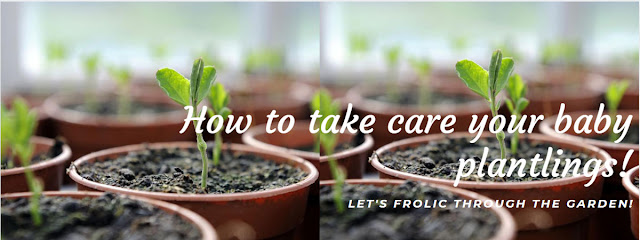How to Take Care Your Baby Plantlings !!!
- Get link
- X
- Other Apps
Gardening naturally supplies a good looking range of natural and organic crop coverage and enabling the gardeners to grow fruit and vegetables without pesticides. The gardening features a number of various kinds of netting to forestall nearly any garden pest destroying our harvests. Bird netting, cabbage white butterfly netting, insect mesh netting to call but a couple of. There are lawn hoops and fruit and vegetable cages for the netting if we required for the trees.
There are organic and natural answers for pest to keep an eye on, the favorite being nematodes for cover towards slugs, vine weevil, leather jackets, ants, chafer grub plus the combination for fruit and vegetable growers.
Caring for Baby Plantlings
Plantlings are living plants that might be in a position to plant and able to nurture. When they have got already sprouted and evolved a strong and healthy root machine we have to provide additional nurturing and a focus as they mature and achieve their full potentials.
-Potting Up
For the very best results, matured Plantlings should be transferred to the coco Peat Pots prior to transplanting them into their final containers. Once matured and past the final frost date in your space, it's possible to transplant them on your garden or into larger indoor potting containers.
-Planting Outdoors
Let the child plant /Plantlings develop in a sunny, south-facing window whilst often watering and fertilizing. For absolute best results, use organic composts once every week. Once the final frost date has handed, you'll be able to transplant them into the ground outdoor. Again, water completely earlier than planting. Never plant dry crops.
-Planting Indoors
If you've got a plan to keep your child Plants indoors, you might wish to transplant them into wider pots. The amount of spacing for each and every number of plants is different from others.
-Direct Sowing
If you need to plant immediately into the garden, be sure to take action after the frost-free date on your space. Watering plant seeds on regular intervals and plant in well-tilled, soil beds should be weed-free, window cans, potting containers or baskets. Water regularly after transplanting, maintaining even moisture until the crops are established.
-Nutrient Care
For perfect effects, fertilize weekly with organic Nutrients.
Light
Light is a plant's most elementary want. Plants make meals thru photosynthesis, which occurs in sunlight. Different vegetation has different light wishes. Learn which form of gentle your explicit plant wishes. The form of light crops want falls into one of three groups:
- Direct sunlight: daylight hits the plant without delay, without any barrier
- Indirect daylight: gentle shine in a room however indirectly on a plant
- Diffused light: light is filtered through a display screen or sheer curtain prior to achieving the plant.
Water
Don't overwater your plant out of sympathy. This is the common mistake a beginning gardeners make. Different crops want different levels of moisture between watering. Some plants like moist soil between waterings, while some others wish to be dry out utterly. Check to determine the water wishes of your vegetation when you are planting them. More vital watering tips:
- Check the soil between waterings with a stick, and even your finger, pushing underneath the highest layer of soil to determine how wet the soil is.
- A watering can is an excellent selection for watering crops. Water smartly across the base.
- Water crops thoroughly. Water must be drained fully from the hole in the backside of the pot.
- Use normal temperature water, since chilly water can shock the roots.
- After watering your vegetation, give them a humidity spice up by means of spritzing them with water.
- Some ornamental pots do not have a drainage hole. You can still use them via potting the plant in a smaller container and striking it within the decorative pot. Be positive you don't set the pot down without delay on the bottom of the container since the roots will sit in water when it drains out of the smaller container. Position some rocks on the backside of the ornamental pot and set the plant container on the peak of them.
Food
Plants have individual diet wishes, and newbies should be careful to not overfeed their plants. Plant meals come in three paperwork:
- Water-soluble: a liquid mixed with water and poured at the plant.
- Spikes: a solid food that is pushed at once into the soil and releases vitamins slowly.
- Granular: sprinkled across the base of a plant and watered in.
When to Repot
When a plant turns into top-heavy or its roots grow out of the drainage hole, it's time to repot.
- Always make a selection of a container that has a drainage hole.
- Placing a small piece of mesh over the drainage hole helps to keep dirt from leaking out of the pot during watering.
- Always use potting soil in your vegetation somewhat than grime from the yard.
- Dampen the potting soil earlier than hanging it around your plant.
- Add slightly soil to the bottom of the pot and tamp it down. Remove the plant from its previous container in moderation, shaking soil free from around the roots so they are going to spread out simply in the new soil. Place the plant in the container and fill it to the highest with potting soil, tamping down firmly across the edges; water totally.
- If you notice brown leaves on the bottom of the plant after transplanting, simply pinch them off.
- After repotting, take a look at the care instructions of every plant for proper placement to fulfill its gentle necessities.
- Get link
- X
- Other Apps




Comments
Post a Comment